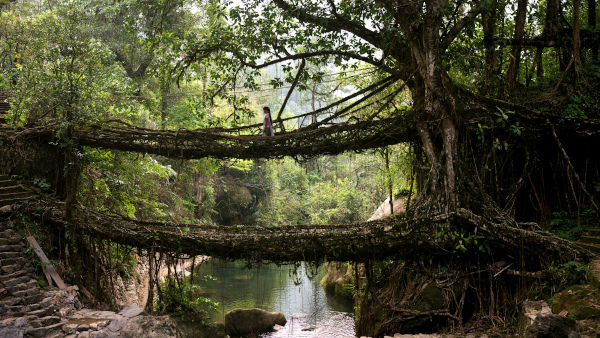MEGHALAYA: They’re not the world’s tallest or longest bridges, but a string of humble river crossings sculpted from tree roots in Meghalaya, India are engineering marvels that contain lessons for modern architects.
Researchers say these little-studied structures, which can stretch for up to 50 meters and last for hundreds of years, could help our cities adapt to rising temperatures associated with the climate crisis.
“It’s really incredible how strong they are and they are growing stronger over time. They are really anchored to the Earth but they don’t have any negative impact on the environment — they part of it,” said Ferdinand Ludvig, professor for green technologies in landscape architecture at the Technical University of Munich and one of the authors of the first systematic study of these “living bridges.”
The bridges stretch across rivers and ravines in India’s mountainous Meghalaya plateau, connecting villages and allowing farmers to access their land. They’re all constructed — or cultivated — from the aerial roots of the same kind of tree: Ficus elastica, or the Indian rubber tree.
Ludwing and his colleagues mapped a total of 74 bridges and unraveled exactly how they were created and maintained by interviewing local residents, taking thousands of photos and building 3D models.
Unlike bridges made from wood or bamboo, they aren’t easily swept away and they don’t rot — a common problem in what is often described as the world’s wettest region. They’ve also proven more durable than bridges made from modern steel structures that quickly rust and decay in the damp climate, said Ludwig.
“It’s an ongoing process of growth, decay and regrowth, and it’s a very inspiring example of regenerative architecture,” he said. The bridges are made and maintained by individuals, families and communities from the indigenous Khasi and Jaintia people.
“In many cases it’s a collaboration of all the inhabitants of two villages. This gives hope that this tradition can survive because it’s on many shoulders.”
Source: AP
Image Courtesy: TripSavvy
You may also like
-
India Can’t Afford to Remain Stagnant at this Juncture, Says PM Modi; Asks People to Buy Locally-Made Goods
-
Stolen Artefacts to be Returned to India from Scotland Museums
-
Netaji’s Hologram Statue at India Gate
-
10th Century Stone Idol of Goat Head Yogini IllegallyRemoved from A Temple in Lokhari, Banda, UP Being Returned to India
-
UNESCO Inscribes ‘Durga Puja in Kolkata’ on the Representative List of Intangible Cultural Heritage of Humanity
